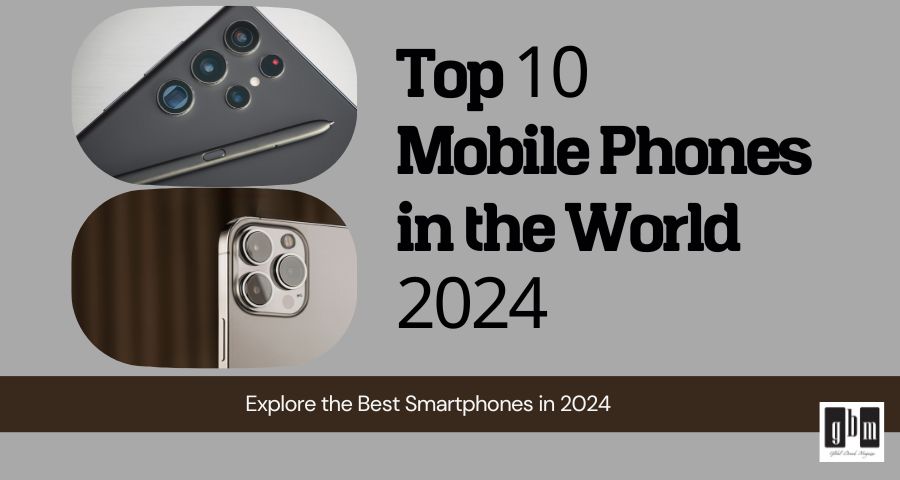Best Smartphones of 2024: A Comprehensive Review of Top 10 Mobile Phones for an Informed Choice

Top 10 Smartphones in the World to Buy in 2024
In a tech-savvy world where smartphones dominate the scene, choosing the perfect device can be a daunting task. To make your decision a breeze, we’ve compiled the definitive list of the top 10 smartphones available in 2024, ranked from 10 to 1. From sleek designs to powerhouse performances, these devices cater to every need and desire.
Let’s dive into the world of cutting-edge technology and explore the best smartphones that 2024 has to offer.
10. Samsung Galaxy S23 Ultra

Samsung Galaxy S23 Ultra: A Comprehensive Review of Top 10 Mobile Phones for an Informed Choice
Pros:
- Stellar build quality
- Impressive camera capabilities
- S Pen functionality for enhanced productivity
Cons:
- Zoom capabilities slightly lag behind competitors
- Premium price tag
Specifications:
- Screen: 6.8-inch 3088×1440 OLED, 120Hz
- Processor: Qualcomm Snapdragon 8 Gen 2 octa-core
- RAM: 8/12GB
- Storage: 256GB/512GB/1TB
- Software: Android 13 with OneUI 5.1
- Cameras: 200MP+12MP+10MP+10MP (rear), 12MP (front)
- Battery: 5000mAh with 45W wired charging, wireless charging, reverse wireless charging
- Dimensions: 163x78x8.9mm, 234g
Buy Now
While the newer Galaxy S24 Ultra may have stolen the spotlight, the Galaxy S23 Ultra remains an impressive smartphone, particularly when considering current offers. If you manage to snag it at a discounted price, you’ll enjoy nearly the same aesthetics and performance as the latest Galaxy S24 but at a lower cost.
Though it lacks the titanium finish and has a slightly weaker zoom capability, the Galaxy S23 Ultra still boasts significant power and incorporates a plethora of S Pen features for productivity enthusiasts. If you’re indifferent to Samsung’s latest AI advancements and zoom capabilities, the Galaxy S23 continues to be a reliable choice, especially when factoring in its current deals.
9. OnePlus Open

OnePlus Open: A Comprehensive Review of Top 10 Mobile Phones for an Informed Choice
Pros:
- Exceptional build quality
- Innovative multitasking modes
- Competitive Pricing
Cons:
- Digital zoom struggles in low light
- Price may be a deterrent for some
Specifications:
- Screen: 6.3-inch 2484×1116 AMOLED with 120Hz (outer), 7.82-inch 2440×2268 AMOLED with 120Hz (inner)
- Processor: Qualcomm Snapdragon 8 Gen 2
- RAM: 16GB
- Storage: 512GB
- Software: Android 13 with OxygenOS
- Cameras: 48MP+64MP+48MP (rear), 32MP (cover), 20MP (inner)
- Battery: 4805mAh
- Dimensions: 153x143x5.8mm (unfolded), 153x73x11.7mm (folded), 245g
Buy Now
While the OnePlus foldable might dent your budget, it undeniably sets a new standard in the foldable phone category. Combining robustness and style, it maintains a form factor barely thicker than a regular handset when folded. The Snapdragon 8 Gen 2 processor ensures exceptional speed, while a trio of sophisticated cameras, featuring a new stacked design from Sony, excels in various shooting scenarios, especially low light.
Boasting vibrant OLED technology and a 120Hz adaptive refresh rate, the outer panel is top-notch, yet it pales in comparison to the 7.82in screen inside, which offers a bright, smooth, and vibrant display with ample space. OnePlus impresses further with innovative multitasking modes, allowing seamless transitions between full-screen and split-screen apps through intuitive gesture swipes. With a price tag lower than competitors like the Google Pixel Fold or Samsung Galaxy Z Fold 5, the OnePlus foldable firmly establishes its five-star status.
8. Motorola Moto G82

Motorola Moto G82: A Comprehensive Review of Top 10 Mobile Phones for an Informed Choice
Pros:
- Outstanding OLED display with 120Hz refresh rate
- Optically stabilized 50MP main camera
- Excellent value for money
Cons:
- Macro camera adds little value
- Faces competition from more powerful rivals
Specifications:
- Screen: 6.6-inch 2400×1080 AMOLED, 120Hz
- Processor: Qualcomm Snapdragon 695 5G
- RAM: 6GB
- Storage: 128GB (expandable)
- Software: Android 12
- Cameras: 50MP+8MP+2MP (rear), 16MP (front)
- Battery: 5000mAh
- Dimensions: 160.9x8x74.5mm, 173g
Buy Now
For those not looking to splurge a fortune on a smartphone, the Motorola Moto G82 offers an enticing option at a sub-£300 price point. Packed with features usually found in more expensive handsets, such as an OLED display with 120Hz refresh rates, a generous 5000mAh battery, and an optically stabilized 50MP camera, it delivers great value for budget-conscious buyers.
While the plastic build and the modest 2MP macro camera reflect compromises made to achieve the lower price, Motorola’s minimalistic approach to Android ensures overall performance remains commendable. The Snapdragon chip, although not breaking benchmark records, contributes to a satisfactory user experience. The main 50MP sensor stands out, producing detailed and realistic images.
Despite its budget-friendly nature, the Moto G82 maintains a neat and no-nonsense packaging. If you seek a mid-tier mobile that excels in the essentials without breaking the bank, this smartphone proves to be an excellent choice.
7. Sony Xperia 1 V

Sony Xperia 1 V: A Comprehensive Review of Top 10 Mobile Phones for an Informed Choice
Pros:
- Comprehensive manual modes for pro photographers
- Stunning 4K OLED display
- Phenomenal performance and day-long battery life
Cons:
- Cameras may not be as user-friendly as competitors
- Comes with a premium price tag
Specifications:
Screen: 6.5-inch 1644×3840 OLED, 120Hz
Processor: Qualcomm Snapdragon 8 Gen 1
RAM: 12GB
Storage: 256GB
Software: Android 12
Cameras: 12MP+12MP+12MP (rear), 12MP (front)
Battery: 5000mAh
Dimensions: 165x71x8.3mm, 185g
Buy Now
Designed for a niche audience, the Xperia 1 V stands out as an exceptionally capable Android handset tailored for photographers. Boasting impressive performance, a cinematic 4K display, and prolonged battery life, it exudes sophistication akin to a sharp business suit. The smartphone excels as a serious tool for skilled photographers, offering rapid burst shooting, extensive manual options, and stellar image quality.
In testing, daylight results showcased exceptional clarity, while low-light images remained sharp, well-balanced, and mostly free from noise, thanks to a new main sensor employing pixel-binning ingenuity and an innovative auto Night mode. Retaining the continuous optical zoom lens from its predecessor, the Xperia 1 V allows users to get closer to subjects without relying on digital tricks. Sony’s comprehensive camera app, coupled with remarkably swift object-tracking autofocus, enhances the photography experience.
While other devices may offer more hand-holding features at a lower cost, the Xperia 1 V caters to photography enthusiasts with deeper pockets, ensuring satisfaction for those seeking a high-performance, specialized smartphone.
6. Google Pixel 7a
Google Pixel 7a: A Comprehensive Review of Top 10 Mobile Phones for an Informed Choice
Pros:
- Fantastic still images for a mid-range phone
- Pure Android 13 experience
- Wireless charging and 90Hz refresh rate
Cons:
- Price bump over its predecessor
- Charging speeds lag behind rivals
Specifications:
- Screen: 6.1-inch 1080×2400 OLED, 60Hz
- Processor: Google Tensor G2
- RAM: 8GB
- Storage: 128GB
- Software: Android 13
- Cameras: 64MP+13MP (rear), 13MP (front)
- Battery: 4385mAh
- Dimensions: 152x73x9mm, 193g
Buy Now
Google’s Pixel 7a continues the tradition of offering a well-rounded and affordable smartphone experience. While slightly pricier than its predecessor, it maintains a streamlined Android experience with its composite shell mimicking premium glass aesthetics. Powered by the Tensor G2 CPU and running pure Android 13 seamlessly, the phone ensures a stutter-free performance.
The Pixel 7a excels in photography, leveraging powerful algorithms to deliver balanced, noise-free, and detailed images. Although lacking a telephoto lens, the rapid autofocus and Night Sight smarts compensate for impressive stills in challenging low-light conditions. With added luxuries like wireless charging and a 90Hz refresh rate, the Pixel 7a stands out as a top choice for a comprehensive and budget-friendly Android experience.
5. Nothing Phone 2

Nothing Phone 2: A Comprehensive Review of Top 10 Mobile Phones for an Informed Choice
Pros:
- Unique and stylish design
- Dependable performance and battery life
- NothingOS 2.0 offers a fresh take on Android
Cons:
- Rivals excel in photography
- Value proposition varies by region
Specifications:
- Screen: 6.7-inch 2410×1080 OLED, 120Hz
- Processor: Qualcomm Snapdragon 8+ Gen 1
- RAM: 8/12GB
- Storage: 128GB/256GB/512GB
- Software: Android 13 with NothingOS 2.0
- Cameras: 50MP+50MP (rear), 32MP (front)
- Battery: 4700mAh
- Dimensions: 162x76x8.6mm, 201g
Buy Now
Elevating its initial smartphone offering, Nothing has refined and enhanced every aspect. The smarter glyph interface now features more LEDs for improved representation of notifications, countdown timers, and real-time updates. The transparent design boasts a sleeker profile with slightly curved rear glass and a larger 6.7-inch screen for a more comfortable grip.
Powered by last year’s flagship chip, the phone delivers commendable mid-range performance. Although the camera hardware remains relatively unchanged, noticeable improvements in image quality, both in daylight and nighttime scenarios, contribute to an appealing overall package. The highlight, however, is the NothingOS 2.0, offering a fantastic take on Android with a consistent style that emphasizes widgets. Positioned as a compelling alternative to the Pixel 8 Pro or OnePlus 11, the Nothing smartphone combines affordability with enticing features.
4. OnePlus 12

OnePlus 12: A Comprehensive Review of Top 10 Mobile Phones for an Informed Choice
Pros:
- Superb Sony LYT-808 sensor
- ProXDR display is epic
- Premium performance
Cons:
- Price increase from the previous model
- Limited color options
Specifications:
- Screen: 6.8-inch 3168×1440 AMOLED, 120Hz
- Processor: Qualcomm Snapdragon 8 Gen 3
- RAM: 12/16GB
- Storage: 128/256/512GB
- Software: Android 14 with OxygenOS
- Cameras: 50MP+64MP+48MP rear, 32MP front
- Battery: 5000mAh with 100W wired, 50W wireless charging
- Dimensions: 164x76x9mm, 220g
Buy Now
Packed with formidable features at a competitive price, the OnePlus 12 continues to impress, although a slight price increase over its predecessor tempers the excitement. Boasting a sleek all-screen design with a tactile matte back, the display stands out with dynamic refresh rates ranging from 1 to 120Hz.
Distinctive OnePlus elements include the trademark alert slider and Hasselblad branding on the circular camera bump, promising enhanced shooting modes. Photography results are consistently impressive, especially in low-light conditions, building on the successes of the previous model.
Expect superb performance, and the 5000mAh battery showcases impressive efficiency. The 100W SuperVooc charging replenishes the battery to full capacity in just over half an hour. For those seeking a flagship experience without breaking the bank, the OnePlus 12 offers a compelling option, undercutting major competitors.
3. Google Pixel 8 Pro
Samsung Galaxy S24 Ultra: A Comprehensive Review of Top 10 Mobile Phones for an Informed Choice
Pros:
- Phenomenal camera performance
- Sharp and refined design
- Extensive software support
Cons:
- Higher price compared to predecessors
- Battery life and charging speeds are average for a flagship
Specifications:
- Screen: 6.7-inch 2992×1344 OLED with 1-120Hz, HDR10+
- Processor: Google Tensor G3
- RAM: 12GB
- Storage: 128/256/512GB, 1TB (US only)
- Software: Android 14
- Cameras: 50MP+48MP+48MP (rear), 10.5MP (front)
- Battery: 5050mAh
- Dimensions: 163x77x8.8mm, 213g
Buy Now
The Pixel 8 Pro has aged gracefully, like a fine wine, showcasing a beautiful design, an eye-catching display, and a camera system that holds its own against the best in the smartphone world, earning its ‘Pro’ title. With extensive software support, it promises longevity, although there are areas where it could improve.
While the device performs well in terms of speed, battery life, and charging, it doesn’t quite reach the pinnacle in these aspects. The increased reliance on generative AI might divide opinions, and the temperature sensor feels more like a passing trend.
When compared to the iPhone 15 Pro Max and Galaxy S23 Ultra, the Pixel 8 Pro maintains competitive pricing, though not significantly cheaper. Opting for this phone over other capable alternatives might require a strong loyalty to the Google ecosystem. But if you’re already immersed in Google’s world, the Pixel 8 Pro is likely to bring you satisfaction and joy.
2. Samsung Galaxy S24 Ultra

Samsung Galaxy S24 Ultra: A Comprehensive Review of Top 10 Mobile Phones for an Informed Choice
Pros:
- Sets new Android toughness standards
- Stellar performance and day-long battery
- Genuinely useful on-device AI
Cons:
- Cameras haven’t progressed much in twelve months
- Price is on the higher side
Specifications:
- Screen: 6.8-inch 3088×1440 AMOLED, 120Hz
- Processor: Snapdragon 8 Gen 3
- RAM: 12GB
- Storage: 256GB/512GB/1TB
- Software: Android 14 with OneUI
- Cameras: 200+12+10+50MP (rear), 12MP (front)
- Battery: 5000mAh
- Dimensions: 162x79x8.6mm, 232g
Buy Now
For those in pursuit of the ultimate smartphone experience, the Samsung Galaxy S24 Ultra emerges as the pinnacle of Android sophistication. Encased in Gorilla Glass Armor and a titanium frame, it seamlessly blends premium aesthetics with rugged durability. The 6.8-inch AMOLED display, now featuring a flat panel, provides a visually stunning experience, complemented by the convenience of the bundled S Pen stylus.
Productivity receives a substantial boost with genuinely helpful on-device AI capabilities, while the Snapdragon 8 Gen 3 CPU ensures peerless performance, outpacing competitors with higher speeds. The Ultra effortlessly handles a myriad of applications, tasks, and games. The top-tier S24 model introduces an enhanced zoom camera with a higher pixel count sensor and a 5x optical zoom, excelling in low-light conditions. While competitors have made strides in picture quality, the Samsung Galaxy S24 Ultra remains a frontrunner, epitomizing the zenith of Android smartphones through its perfect amalgamation of design, functionality, and performance.
1. Apple iPhone 15 Pro Max

Apple iPhone 15 Pro Max: A Comprehensive Review of Top 10 Mobile Phones for an Informed Choice
Pros:
- Great camera improvements
- USB-C connectivity
- Lighter and nicer to hold
Cons:
- USB 3 rather than Thunderbolt
- No desktop mode
Specifications:
- Screen: 6.7-inch 2796×1290 OLED HDR, 460ppi
- Processor: A17 Pro
- RAM: 8GB
- Storage: 256GB/512GB/1TB
- Software: iOS 17
- Cameras: 48+12+12MP (rear), 12MP (front)
- Battery: 4,441 mAh (estimated)
- Dimensions: 76.7×159.9×8.25mm, 221g
Buy Now
The iPhone 15 Pro Max stands out as Apple’s finest creation to date. Remarkable camera upgrades, the long-awaited inclusion of USB-C, and the practical Action button enhance an already stellar lineup of components, including the display, speakers, and app ecosystem. While some may argue that the changes are more iterative than revolutionary, this perspective often stems from tech journalists accustomed to a constant influx of new phones. For those with last year’s Pro Max, the differences might not justify an upgrade unless you’re a passionate photographer or eagerly anticipating USB-C. However, for everyone else seeking the pinnacle of what Apple has to offer, the iPhone 15 Pro Max is unequivocally the best choice, provided your budget allows.
What is the top-tier smartphone on the market right now?
In our assessment, the Apple iPhone 15 Pro Max stands out as the premier choice. While it maintains the familiar pull-shaped Dynamic Island cutout, it boasts a trio of highly proficient cameras, resilient A17 Pro silicon, and, notably, the inclusion of USB-C. If you’re willing to invest, the iPhone 15 Pro Max represents the pinnacle of current smartphone offerings.
Looking for alternatives?
Here are our recommendations for the best smartphones in various categories:
Best Android Phone: The Samsung Galaxy S24 Ultra excels in nearly every aspect. From its captivating design to stellar display and performance, this phone is a comprehensive package. The addition of the S-Pen stylus and innovative AI features further solidify its status as an outstanding all-around choice.
Best Affordable Smartphone: For those seeking a budget-friendly option without compromising on quality, the Google Pixel 7a showcases Google’s mastery in crafting affordable yet excellent phones. With a sleek design and top-notch camera capabilities, it stands out as a wallet-friendly winner.
Best Folding Phone: The OnePlus Open takes the lead in the realm of foldable smartphones. With its streamlined design, impressive cameras, and smooth software, it has established itself as the premium choice in the foldable category. Featuring a convenient 6.3-inch cover display and a substantial 7.82-inch unfolded display, it combines style with functionality.
Best Phone for Photography: If your primary focus is on capturing exceptional photos, the Google Pixel 8 Pro (available for purchase now) takes the crown as the ultimate camera phone. Boasting a 50MP main camera and 48MP wide and telephoto cameras, it’s not just the hardware that sets it apart—it’s the software. Thanks to Google’s intelligent AI features and editing capabilities, achieving impressive photos with the Pixel 8 Pro is virtually foolproof.
Whether you prioritize cutting-edge technology, affordability, or photography prowess, these recommendations cater to diverse preferences in the ever-evolving world of smartphones.
As we embark on a journey through the latest innovations in the smartphone market, let’s pause for a moment of reflection on the standout performers from yesteryears. In a previous article spotlighting the top 10 selling smartphones of 2023, we explored the undisputed dominance of industry behemoths such as Apple and Samsung. This retrospective view offers a captivating glimpse into the intricacies of consumer preferences and the dynamic shifts that have shaped the ever-evolving tech landscape.
In conclusion, selecting the perfect smartphone involves weighing crucial factors such as operating systems, budget, size, performance, and specific features like camera capabilities and gaming prowess. Whether you prioritize iOS or Android, have a set budget, or seek specific performance attributes, making an informed decision ensures your smartphone aligns seamlessly with your needs and preferences.
The Apple iPhone 15 Pro Max claims the throne as the best smartphone of 2024, offering a blend of exceptional camera enhancements, USB-C connectivity, and an overall refined user experience. Whether you’re a photography enthusiast, an Android aficionado, or an iOS loyalist, this list caters to every preference, ensuring you find the perfect device to complement your lifestyle. Happy smartphone shopping!















